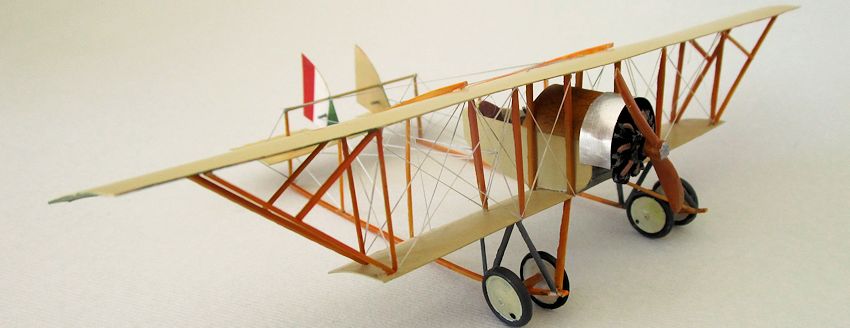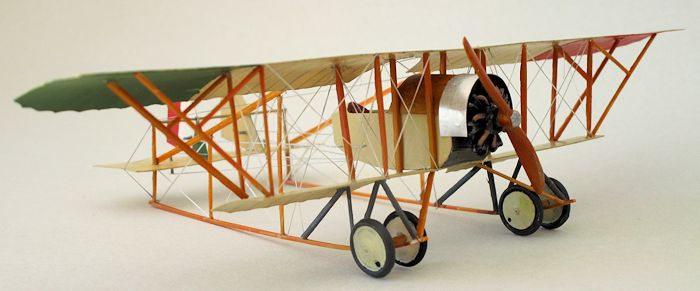
1/72 Caudron G.3
| KIT #: | |
| PRICE: | $Cheap, very cheap |
| DECALS: | None |
| REVIEWER: | Chris Peachment |
| NOTES: | Made from 10 and 20 thou plastic card, rod and strut, as well as several bottles of wine. |

| HISTORY |
The Caudron G.3 was designed by the brothers René and Gaston Caudron as a trainer and reconnaissance aircraft, and it first flew in May 1914. As you can see, it has a short nacelle for the crew, and twin booms for the tail, in spite of having a nose mounted engine, which is unusual. The sesquiplane layout used wing warping for lateral control, although later marks had ailerons. It was usually unarmed, although sometimes it was equipped with light machine guns and small bombs. The man in the back seat was sometimes seen with a rifle or shotgun.
 It was built in very large quantities after the outbreak of WWI, with Caudron
building 1,423 of the 2,450 built in France. Two hundred and thirty three were
also built in England and 166 in Italy, along with several other countries. As
an act of patriotism, the Caudron brothers did not charge a licensing fee for
the design.
It was built in very large quantities after the outbreak of WWI, with Caudron
building 1,423 of the 2,450 built in France. Two hundred and thirty three were
also built in England and 166 in Italy, along with several other countries. As
an act of patriotism, the Caudron brothers did not charge a licensing fee for
the design.
And it goes down in the record books as being the aircraft of choice for one Adrienne Bolland, who in 1921 became the first woman to fly across the Andes. Why no woman had attempted this previously is a mystery.
The United States Air Service even used one for taxi training, and clipped it wings so that it couldn't accidentally become airborne, a boon to nervous student pilots.
As the many photos available of this aircraft attest, it is on display in many museums around the world, including the RAF Museum Hendon, and Rio de Janeiro. One should be careful using these for reference however. Restoration teams have used many different layouts. The cockpit for example sometimes had a coaming between the two pilots, and sometimes not. Restored flying examples often show a plain wooden bar between the two crew with extra instruments on it. The original had very few, and all of them in front of the forward pilot.
 As you can see in this website's Readers' Forum, modellers often have fun by
compiling lists of aircraft they would like to see in manufacturers catalogues.
Indeed there are often some surprising omissions. For myself, I would very
much like Airfix to produce the 1930s Humbley-Pudge Gallipoli Heavy-ish Bomber,
as designed by Bruce McCall. The last surviving example of which is used as a
hen-house by the Maharani of Gunjipor. Despite her constant reminders, the RAF
keeps forgetting to reclaim it.
As you can see in this website's Readers' Forum, modellers often have fun by
compiling lists of aircraft they would like to see in manufacturers catalogues.
Indeed there are often some surprising omissions. For myself, I would very
much like Airfix to produce the 1930s Humbley-Pudge Gallipoli Heavy-ish Bomber,
as designed by Bruce McCall. The last surviving example of which is used as a
hen-house by the Maharani of Gunjipor. Despite her constant reminders, the RAF
keeps forgetting to reclaim it.
However, the Caudron here is a genuinely surprising omission from the Eduard or AZ or Special Hobby range, since it was produced in such large numbers. But as far as I can see there is no injection model of this very likeable little beast, and so if the mountain won't come to Muhammad, then scratchbuilding is the only answer.
| CONSTRUCTION |
Plans are available all over the place on the internet, as well as some excellent very large photos of the aircraft, many of them airworthy. There is one wonderful picture of a chap flying it from the back. He looks very dashing, lounging back in his leather upholstered seat, one elbow over the side of the cockpit, while his white silk scarf trails behind him in the slipstream. I can think of no nicer place to be.
Scrutiny of the pictures reveals that the flying surfaces are very thin
indeed in cross section, and so I made them from one leaf of 10 thou card,
scored for the ribs with a black biro underneath, and taped around a paint brush
of suitable diam eter to get the camber right. No need to score ailerons unless
you want a later model.
eter to get the camber right. No need to score ailerons unless
you want a later model.
The boat shaped cockpit nacelle was made from 20 thou sheet, and note that the forward panel was plywood, which sits slightly proud of the main body. Some models had metal plates here, some had extra plywood down the sides to the wing roots. The cockpit is wide open and so some detailing is necessary. Wood painted strips for the interior ribs. The front seat is an average sort of WWI plywood bucket seat, with holes drilled in the back to add lightness. The rear seat however is a much more luxurious item, rather like a gentleman's club armchair.
I did the cushions for that from some putty, pricked on the seat for the buttons, and ribbed on the back to represent the tuck and roll leather. There are a couple of decal dials are on the front panel, two joysticks, unadorned by grips of any kind, and two throttles, which are simply bent rod.
After that the lower wing can be fixed to the lower side, noticing that only the forward half connects, and the rear half doesn't. The angle of incidence on this aircraft is large.
Struts were made from strut shaped rod, although they need thinning at both
ends, which is a tedious process, but makes quite a difference to the look of
the thing. I see that some of the few 1/72 examples on the internet make a big
deal of the two or three bandages encircling each strut. They are indeed
prominent on some aircraft. But on many others, they are a neutral brown sort of
colour which doesn't show up on the strut. I decided not to do them, since life
is short
If like me you choose to do one from the Italian Air Force, don't forget to paint the outer panels of the upper wing underside in the right shade of red and green.
With wings this thin it is impossible to drill for the strut locations, so each strut was held in place solely by glue, which is a nightmare for alignment, and also leaves the finished model very flimsy. If you handle it with kid gloves, you will surely break it into a hundred pieces.
The twin booms are square section, made from edge-cuts of 40 thou card. Note that the booms also double as the skids for the landing gear. If you can get the four wheels, and the two long booms all sitting on the ground together, then you are a master modeller and I hate you. It took me about three goes before I was happy, and there is still daylight here and there, mainly due to the curvature of the grey sheet of paper on which it rests for the photos. When it sits on the shelf, I don't look here and there.
The tail planes were cut from card, and the fins and rudders painted in that lovely combination of red, white and bright green.
Rig the wings, booms and tail.
It took two seconds to write that sentence and a week of evenings spent
finagling around with thick-lensed reading glasses, tweezers, elastic thread and
superglue. Once the wings are done, don't forget to do the control lines running
from the cockpit to the rudd ers and elevators. It adds that little extra
something.
ers and elevators. It adds that little extra
something.
The Rhone 9 cylinder engine is the sort with the induction tubes at the front, so I used one of my ancient Aeroclub metal ones, which has been sitting in its plastic pouch for a good 10 years, waiting for its hour to come around.
The propeller comes from the spares box, but first you must decide on the cowl. Usually this was a semi-enclosing one, of the kind which the Fokker Triplane sported. The sort of thing on which Germans used to demonstrate their sense of humour, by painting on a pair of eyes and a handlebar moustache. Some of the Caudrons had no cowl at all, which looks a little bare to my eye, as if the riggers forgot to put one on.
I did indeed have an old Triplane cowl in the spares box, but decided that life was getting far to easy after all that rigging, and chose to make the simple semi-circular cowl from the lead foil of a wine bottle. I had to open several bottles before I had a large pile of foil. This hobby demands sacrifice. Superglueing it in place is not recommended if you have drunk the wine.
| CONCLUSIONS |
 There you have one featherweight trainer and reconnaissance aircraft which
was very popular with its crews because of its good handling and also its high
rate of climb. Don't show it anywhere where childish little fingers might try to
pick it up. It is extremely fragile, and if you grip one end of the upper wing,
it simply bends and the whole thing sags towards the ground. Put it on a high
shelf, well away from any draughts. The slightest breeze will make it take off.
That probably applied to the original since it had a top speed of only 60 mph.
There you have one featherweight trainer and reconnaissance aircraft which
was very popular with its crews because of its good handling and also its high
rate of climb. Don't show it anywhere where childish little fingers might try to
pick it up. It is extremely fragile, and if you grip one end of the upper wing,
it simply bends and the whole thing sags towards the ground. Put it on a high
shelf, well away from any draughts. The slightest breeze will make it take off.
That probably applied to the original since it had a top speed of only 60 mph.
| REFERENCES |
http://www.ctie.monash.edu.au/hargrave/caudron.html
http://www.finemodelworks.com/arizona-models/reference/Thumbs/Aircraft/France/Caudron/G3/G3.html
http://www.militaryimages.net/photopost/member-galleries/p24691-venezuelan-air-force-caudron-g3.html
http://www.airliners.net/photo/Caudron-G-3/1809083/L/
http://data3.primeportal.net/hangar/domeric_barbot/caudron-g3/images/caudron-g3_01_of_23.jpg
October 2015
If you would like your product reviewed fairly and fairly quickly, please contact the editor or see other details in the Note to Contributors.